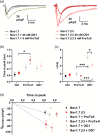The β3-subunit modulates the effect of venom peptides ProTx-II and OD1 on NaV 1.7 gating
- PMID: 37042220
- PMCID: PMC10953403
- DOI: 10.1002/jcp.31018
The β3-subunit modulates the effect of venom peptides ProTx-II and OD1 on NaV 1.7 gating
Abstract
The voltage-gated sodium channel NaV 1.7 is involved in various pain phenotypes and is physiologically regulated by the NaV -β3-subunit. Venom toxins ProTx-II and OD1 modulate NaV 1.7 channel function and may be useful as therapeutic agents and/or research tools. Here, we use patch-clamp recordings to investigate how the β3-subunit can influence and modulate the toxin-mediated effects on NaV 1.7 function, and we propose a putative binding mode of OD1 on NaV 1.7 to rationalise its activating effects. The inhibitor ProTx-II slowed the rate of NaV 1.7 activation, whilst the activator OD1 reduced the rate of fast inactivation and accelerated recovery from inactivation. The β3-subunit partially abrogated these effects. OD1 induced a hyperpolarising shift in the V1/2 of steady-state activation, which was not observed in the presence of β3. Consequently, OD1-treated NaV 1.7 exhibited an enhanced window current compared with OD1-treated NaV 1.7-β3 complex. We identify candidate OD1 residues that are likely to prevent the upward movement of the DIV S4 helix and thus impede fast inactivation. The binding sites for each of the toxins and the predicted location of the β3-subunit on the NaV 1.7 channel are distinct. Therefore, we infer that the β3-subunit influences the interaction of toxins with NaV 1.7 via indirect allosteric mechanisms. The enhanced window current shown by OD1-treated NaV 1.7 compared with OD1-treated NaV 1.7-β3 is discussed in the context of differing cellular expressions of NaV 1.7 and the β3-subunit in dorsal root ganglion (DRG) neurons. We propose that β3, as the native binding partner for NaV 1.7 in DRG neurons, should be included during screening of molecules against NaV 1.7 in relevant analgesic discovery campaigns.
Keywords: NaV1.7; OD1; ProTx-II; pain; voltage-gated sodium channel; β3-subunit.
© 2023 The Authors. Journal of Cellular Physiology published by Wiley Periodicals LLC.
Conflict of interest statement
The authors declare no conflict of interest.
Figures







References
Publication types
MeSH terms
Substances
Grants and funding
LinkOut - more resources
Full Text Sources

